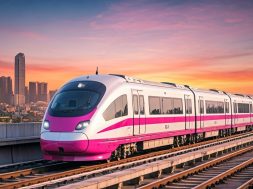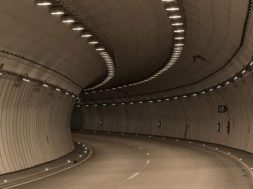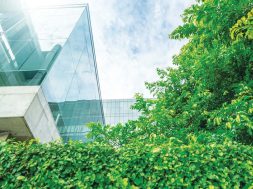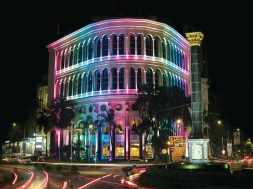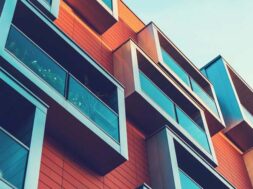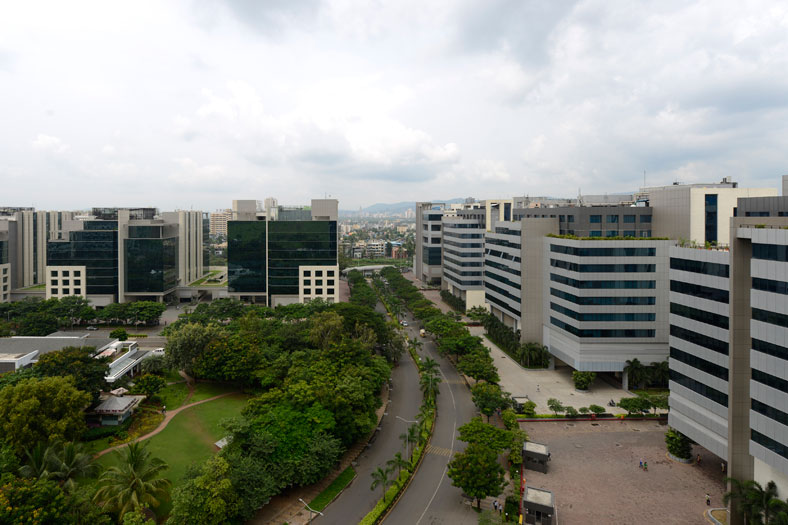
Discussion on why office building should go all glass
Glass today, has become an integral part of modern day architecture. Using glass in a building instantly adds a touch of modernity to the living space. It not only gives the designers the choice of finish and a manifestation to their design aspirations, but also a wonderful chance to participate with the outside world. Glass, in fact, is the only building material which can not only give see-through properties but also the desired structural strength to be used in facades.
Glass ensures that the commercial spaces and offices get ample natural light – making interiors look brighter and livelier reducing the need for artificial lighting and saving energy, or in other words, reducing the electricity bill. Ample light inside the office makes spaces look more spacious, an important factor to consider given today‘s shrinking living spaces in urban areas. “Optimum day lighting also has positive impact on the employees’ efficiency,” believes Vikram Khanna, COO – Consumer Glass, COO – Architectural Institutional Business, CMO, CIO, Asahi India Glass Ltd. (AIS).
He adds, “Energy efficient glasses provide the benefit of reducing the heat gain in buildings due to its excellent energy saving properties without compromising on the natural light coming inside the building or the brilliant aesthetics that add value to the façade. And in winter, they ensure solar gain. So that no matter what the season, people inside stay comfortable at all times. Using energy-efficient glass also helps in ensuring that the interiors – and employees – feel more comfortable. Ideal for solar and thermal insulating parameters, these glasses combine aesthetics with environmental sensibility and conform to all International and National Green Standards, making it the natural choice as a green building solution. Performance parameters of glasses like visual light transmission, solar factor, U-Value and internal reflection make buildings more efficient and ecologically viable.”
Keyur Barad, Founder & CEO, Gecko Worldwide also believes, “Glass buildings also retain heat and light which saves on the energy consumption. Since glass is a bad conductor of heat, it saves energy in the air conditioning of buildings. Glass also helps in maintaining a stability of temperature in the environment.”
Glass once had only limited use in construction as it was considered too breakable and brittle. With modern reinforced and strengthened glazing readily available, its application in construction has increased manifold.
Ar. S P Anchuri, Chief Consultant, Anchuri & Anchuri believes that glass facades encourage communication with the external world but one needs to be careful and also should know there are few limitation with glass. He says, “Going for all glass for office buildings we must be careful as there are some limitations with the glass. It is costly and may increase construction costs also not advised for use in earthquake prone areas and not only as per me All-Glass is fine but not too much of it always. Use of better glass, better design, better codes ,better measurement standards and above all better training, where construction practices do not stress air sealing or preventing thermal breaks, and trades can do better.”
Anchuri adds, “If one carefully adopts the said principles for using All-Glass then it creates a high quality work environment for their employees. An exterior of the building with transparent floor-to-ceiling, all-glass facade that encourages openness and communication with the external world.”
Agreeing upon Anchuri’s views Dhaval Ajmera, Director, Ajmera Realty says, “Use of glass allows outside greenery and natural beauty to be enjoyed inside the building, and it ensures a better working environment. Thanks to its transparency, glazing enables daylight to penetrate the interiors of buildings and provides a view to the outside world. The choices offered by glass glazing companies are numerous and, according to the specific projects, the right decisions can be made about what kind of glass to use for durability, strength and appearance.”
Speaking on why office buildings should go all says Ar. Sabeena Khanna, Studio K.I.A says, “All-glass buildings translate to speed of construction due to the curtain-wall assemblies and also ease the design aesthetics to a great extent.”
Even though increased glazing area comes with energy penalties, technological advancements and innovations have significantly improved the insulation properties of all-glass facades. Such glazing products allow maximum natural daylight into buildings and can also maximise or limit solar heat gains, depending on the desired thermal objectives and energy balance. Glass offers both a positive balance of energy through the building envelope, and the provision of sufficient daylight to reduce artificial lighting needs.
The use of layered, double or triple glazing with inert gas filling and invisible low emissivity coatings, insulated spandrel panels for glazing, spectrally selective low-e glazing can be further supplemented with exterior roller blinds or shades, tinted or coated glass, etc as strategies to regulate energy flow.
Ar. Sabeena adds, “Sustainable upgrades like a green version of glass which is low-e glazing, is coated with metallic oxide to block the sun’s harsh rays during summer and keep the heat inside in the winters, can be resorted to. It significantly brings down HVAC costs as well. A more advanced version of this is smart glass or the electro chromic glass which is now being used. By the use of a small amount of electricity, the smart glass charges ions to control the amount of light it reflects. In effect, this glass tints during the sun’s peak hours and returns to transparency at night.”
Even Rohan Agarwal, Managing Director, Geopreneur Group believes that low-e glass is useful, “Glass buildings tend to get more heated up due of the direct exposure to the sun and this disadvantage of the glass-building can be overcome by those of low-e glass by increasing the layers of glazing, providing exterior shading elements which can also become an architectural feature of the building facade.”
Designers today can go ahead and make the smartest use of glass to create low energy buildings that suit all climates and yet generate minimal environmental impact. Thus, all-glass buildings with sleek, smooth, bold and shimmering effects are here to make an interesting skyline.
Commercial structures, especially workspaces – like offices – need to maintain the ideal environment within the premises. “We talk about architecture and construction stability, the next important aspect is a healthy environment within for the human resource that works within the building. This is where a glass facade makes sense instead of an RCC structure – one can have natural light during the day time, effectively, saving on lighting costs – as also saving electricity – in effect, putting less pressure on the power generation plants – and in effect, saving the ecology, maintaining nature. This also makes sense when one considers HVAC and how a glass façade helps maintain optimum temperature across the structure. Plus, you have the aesthetics aspect, glass facades do give office buildings the ‘modern work-space’ look,” says Niranjan Hiranandani, CMD, Hiranandani Communities.
“The overall purpose of utilising glass for commercial buildings is to minimise the amount of artificial light which lessen electricity and HVAC costs. Electrical lighting generates a lot of heat, whereas, if properly controlled, natural light generates hardly any heat at all. For most buildings incorporating daylighting, the overall energy savings range from 15 to 40 per cent. Glazing is another technique used wherein a Low ‘e’ double glazed glass is used to reduce the heat ingress into the building. These windows help to make the indoor area more comfortable and contributes to creating a brighter, cleaner and healthier environment,“ states Shabbir Kanchwala, Senior Vice President,K Raheja Corp.
Is glass just a vogue?
Not always that people will prefer glass just because it beautifies the building. There are few drawbacks which makes glass a not so preferable material. Ar. Prem Nath, Prem Nath & Associates believes that applying glass on buildings is a fashion. He says, “Who says that a office building should be ‘all glass’ – this is just a fad – it’s just that the glazed buildings are in vogue, thanks to our all-time inspiration from the western countries; office buildings need not be all glass, they need to be a perfect balance between glass and opaque surfaces; while glass is an exceptionally green material, the reflections caused by it also causes, what we call, the green house effect.” Greenhouse effect is the trapping of the sun’s warmth in a planet’s lower atmosphere, due to the greater transparency of the atmosphere to visible radiation from the sun than to infrared radiation emitted from the planet’s surface; this adds to the global warming. However he observes, “It is important to plan a building in most contemporary style, however as an architect of repute, having been responsible for various commercial projects in India, I feel that a balance between low-e or solar glass and an opaque surface like ACP or exterior laminate shall not only cut the direct reflections but also enable one to create a good looking building elevation. In time to come (in-fact it has already started) we shall be able to use glazing with photo-voltaic cells embedded within – these shall not only enable one to reduce the green house effect, but also capture the advantageous component of the sunlight and convert it to solar power.”
Rahul Kadri, Principal Architect, Kadri Consultants Pvt. Ltd also says, “I do not completely agree that office buildings should go ‘all glass’. Meaningful buildings are those which have a site sensitive design in harmony with nature. Designs should embody low energy costs by adapting to green concepts ranging from the basics of orientation and effective material use.”
If a building has to go ‘all glass’, it would need an additional climate sensitive envelop to create a functional, robust and energy efficient space within believes Kadri. As seen in most historical structures, Jalis and perforated screens serve as efficient shading devices. He informs, “In our latest office building at Aurangabad, we have used a combination of glass and screens to create an optimum light and air quality in the internal spaces. The building is wrapped with an intricate modular Jaali derived from traditional motifs found on the historic Bibi-ka-Maqbara in Aurangabad.” The Jaali screen controls the airflow and lowers the temperature of internal spaces whilst also providing natural diffused sunlight. A network of three screen modules of the same motif but varying scales form the screen. This breaks the monotony of the Jaali façade as well as helps control the light and shadow for open terraces and office spaces accordingly.
To lighten the building and bring in north light ideal for workspaces, the building is enclosed with a light glass façade at the entrance face. Glazed with fritted glass, the screen motif is embossed on the glass panels as well, echoing the theme of the building. The building is oriented to allow maximum glare-free light into the office spaces whilst minimising heat gain. With staggered terraces punctuating the atrium volume and north light filtering through the glazed façade, the atrium forms a vibrant center of activity.
Hence by simply going ‘all glass’, office buildings cannot achieve maximum efficiency. For a building to be truly inspirational and timeless, it needs to be contextual, sustainable and environmentally holistic – through careful articulation of form, materials, textures and proportions.
“Well, the simple answer is that they should not go all glass, states Amit Khanna, Founder & Design Principal, AKDA. He believes, glass is an excellent material for exterior cladding, but the appropriate use of glass is mandatory before it can be classified as the right material for office buildings. There are many factors which determine whether or not glass is being used correctly on a building facade. Factors like the size of the glass, thickness; the choice of insulated, toughened and laminated glass is often seen as a mutually exclusive selection. However, the correct solution often relies on a combination of these for the best result. Lastly, the possibility to integrate other materials into the overall building design can help reduce the visual impact of an all glass building. Popular choices include stone and aluminium panels, however solar panels are also becoming popular as a possible material to supplement glass in exterior cladding.
Cookie Consent
We use cookies to personalize your experience. By continuing to visit this website you agree to our Terms & Conditions, Privacy Policy and Cookie Policy.
